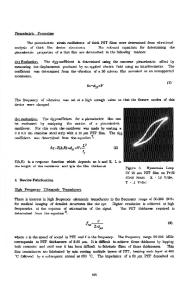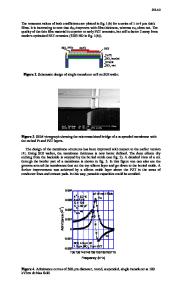Fabrication of Piezoelectric ZnO and PZT Films for FPW Device
- PDF / 1,254,939 Bytes
- 6 Pages / 612 x 792 pts (letter) Page_size
- 100 Downloads / 375 Views
0966-T07-07
Fabrication of Piezoelectric ZnO and PZT Films for FPW Device Sang Hoon Yoon and Dong-Joo Kim Materials Research and Education center, Auburn University, 201 Ross Hall, Auburn, AL, 36849 Abstract Piezoelectric ZnO and PZT films for acoustic wave device have been investigated. The films used for acoustic wave devices require textured structure, high piezoelectric coefficients, and high electromechanical coupling coefficients, because the piezoelectric films launch and receive the acoustic wave. We fabricated ZnO films by RF magnetron sputtering, and PZT films by chemical solution deposition (CSD). Results showed that uniform, dense and highly textured films were obtained under optimal process parameters. The film texture was controlled by modifying process parameters, such as gas kinds, gas ratio, and substrate type for sputtered ZnO films, and the presence of chelating agent, temperature of heat treatment, and substrate type for solution derived PZT films. Flexural plate wave (FPW) device has been successfully integrated onto 4-inch silicon wafers with optimized piezoelectric films. Introduction Among the acoustic wave devices, FPW device has been attracted for biosensor application[1], because it has distinctive sensitivity than others, due to its thin membrane. There have been numerous studies on ZnO[2] and PZT[3] films as promising materials, because of their high piezoelectric and electromechanical constants, stable dielectric constant, and chemical stability. When the electric signal is given by input IDT (Interdigital Transducer), it generates the mechanical deformation of the materials by converse piezoelectric effect, initiating the acoustic wave propagating through the membrane of FPW device. The mechanical deformation can be transformed to electric signal at output IDT by piezoelectric effect. For the application, highly textured structure of the piezoelectric materials is needed. Moreover, the roughness of the device surface is another important factor to be investigated, because of the acoustic wave propagating through the membrane. For the acoustic wave device application, ZnO films have been fabricated by the spray pyrolysis[4], metalorganic chemical vapor deposition[5], pulsed laser deposition[6], sol-gel[7], and DC and RF sputtering[8]. Among them, sputtering has been most widely used for the fabrication of ZnO films, because it is an effective way to obtain good adhesion onto a substrate, uniform and dense structure, and smooth surface. It has been reported that the film orientation can be controlled by substrate[9], annealing temperature[10], sputtering temperature and pressure, and argon-oxygen gas ratio[11], and RF power[12]. PZT (Lead zirconia titanate, Pb(ZrxTi1-x)O, x≈0.53) films have also been investigated for piezoelectric transducer such actuator and sensor[13] due to their excellent electromechanical properties at the morphotropic phase boundary (MPB). For piezoelectric devices, PZT films have been deposited onto various substrates by chemical solution deposition (CSD), becaus
Data Loading...










